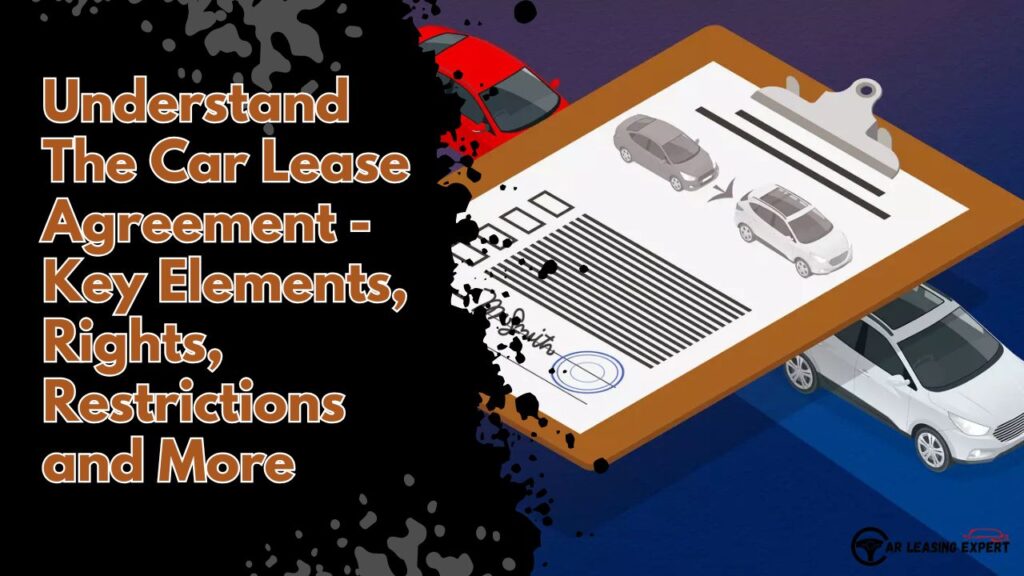When it comes to getting a car, leasing is a popular alternative to buying. A car lease agreement describes the terms and conditions of leasing a vehicle, ensuring that both parties (the lessor and the lessee) are protected.
The car lease agreement details the terms under which the vehicle is leased, including usage, duration, costs, and responsibilities. This agreement ensures that both parties understand their rights and obligations. It is essential that both parties fully understand the details of this contract to avoid misunderstandings or disputes later
What is a Car Lease Agreement?
A car lease agreement is a legally binding contract between a lessee (the person renting the vehicle) and a lessor (the leasing company or dealer). This contract outlines the terms and conditions under which the lessee agrees to rent the vehicle for a specific period of time.

Understanding a Car Lease Agreement Important for Both Parties
Understanding a vehicle lease agreement provides financial clarity, ensures proper vehicle use and maintenance, and protects the interests of both parties, leading to a successful and transparent leasing experience.
Lessee: Understanding the contract provides financial clarity and helps the lessee manage the budget effectively. Knowing the payment structure, additional fees, and penalties prevents unexpected costs. It ensures that the lessee is aware of usage rights, mileage limits, and maintenance responsibilities, helping the lessee avoid penalties and comply with the terms of the lease.
Lessor: Understanding the contract protects the lessor’s investment by clearly defining the lessee’s obligations regarding vehicle use and maintenance. This ensures that the vehicle is kept in good condition and returned properly. Additionally, it allows the lessor to enforce the terms, address issues promptly, and ensure the financial viability of the lease agreement.
Key Elements of a Car Lease Agreement
1. Vehicle Information
The contract includes detailed information about the rented vehicle, such as the make, model, year, VIN (vehicle identification number), and any additional features or options included in the rental agreement.
2. Rental Agreement Term
The rental agreement term specifies the length of the contract, which typically ranges from 24 to 48 months. It also includes the start and end dates of the rental period.
3. Monthly Payments
The contract outlines the monthly lease payments, which are calculated based on factors such as the vehicle price, interest rate (money factor), and residual value. It also specifies the due date for monthly payments and any penalties for late payments. You can use Lease Calculator to calculate your monthly payments.
4. Mileage Allowance
Most car rental agreements include a mileage allowance, which typically ranges from 10,000 to 15,000 miles per year. The contract specifies the mileage allowed and any excess mileage charges if the lessee exceeds the limit.
5. Maintenance and Repairs
The contract details the lessee’s responsibility to maintain and repair the vehicle during the lease period. This may include regular maintenance, oil changes, tire rotations, and any necessary repairs.
6. Wear and Tear
The lease agreement outlines what constitutes normal wear and tear versus excessive wear and tear. It specifies the lessee’s responsibility for any damage beyond normal wear and tear and any associated costs at the end of the lease.
7. Insurance Requirements
The lessee is typically required to maintain comprehensive and collision insurance coverage for the leased vehicle. The contract specifies minimum insurance requirements and proof of coverage.
8. Purchase Option
Some lease agreements include a purchase option, which allows the lessee to purchase the vehicle at the end of the lease period. The contract details the purchase price and any associated fees or conditions.
9. Early Termination
The contract outlines the conditions and penalties for early termination of the lease. This may include early termination fees, remaining lease payments, and any additional fees for early returning the car before the end of the lease term.
10. Obligations at Lease End
At the end of the lease term, the contract specifies the lessee’s obligations, such as returning the vehicle, paying any fees for excess mileage or wear, and completing required inspections.
11. Fees and Penalties
The contract outlines various fees, such as acquisition fees, disposition fees, and penalties for late payments, excessive wear, or early termination of the lease.
What Rights Do Renters Have Under A Car Lease Agreement?
Lessees have the right to use the vehicle as specified in the lease agreement, receive a well-maintained vehicle, and be protected from unreasonable charges.
- Right to use the vehicle: Lessees have the right to use the leased vehicle according to the terms outlined in the lease agreement. This includes adhering to specified mileage limits, maintenance schedules, and any usage restrictions. They have the right to drive the vehicle for personal or business purposes as long as they comply with the agreed-upon conditions.
- Right to a well-maintained vehicle: Lessees have the right to receive a vehicle that is in good working order at the start of the lease. The lessor is responsible for ensuring that the vehicle is safe, roadworthy, and meets all legal standards. If any problems arise that are not caused by the lessee’s misuse or negligence, the lessor is generally responsible for repairs under the terms of the lease.
- Protection from unreasonable charges: Renters are protected from unreasonable or unexpected charges during and at the end of the lease period. The lease agreement should clearly outline all potential charges, including those for excessive wear and tear, exceeding mileage limits, or early termination. Renters have the right to dispute any charges they feel are unfair or not clearly stated in the agreement.
Things to Consider Before Signing a Car Lease Agreement
Lessees should carefully evaluate several factors before signing a car lease to ensure it fits their needs and budget. Here are key considerations:
1. Budget and monthly payments
Affordability: Make sure the monthly lease payments fit within your budget. Consider additional costs such as insurance, maintenance, and possible excess mileage charges.
Down payment: Evaluate the required down payment and how it affects the total cost of the lease. A larger down payment can reduce monthly payments.
2. Mileage allowance
Annual mileage: Check the mileage allowance included in the lease. If you expect to drive more miles than allowed, negotiate a higher limit or prepare for excess mileage charges.
Excess mileage charges: Understand the cost per mile if you exceed the mileage allowance. These charges can add up quickly.
3. Lease Term
Length: Consider the length of the lease term, which typically ranges from 24 to 48 months. Make sure the term fits your driving needs and future plans.
Flexibility: Consider potential early termination penalties if you need to end the lease before the term expires.
4. Residual Value
Lease-End Options: Residual value is the estimated value of the vehicle at the end of the lease. This value affects the price of the purchase option if you decide to buy the vehicle at the end of the lease term.
Depreciation: A higher residual value can result in lower monthly payments, as it indicates slower depreciation.
5. Maintenance and Repairs
Maintenance Requirements: Review maintenance requirements and your responsibility to keep the vehicle in good condition. Regular maintenance and repairs may be your responsibility.
Wear and Tear: Understand what constitutes normal wear and tear versus excessive wear and tear. Be aware of potential charges for any damage beyond normal wear and tear.
6. Insurance Coverage
Insurance Requirements: Confirm the insurance coverage required for the rental vehicle. Rental companies typically require comprehensive insurance and collision insurance.
Cost: Consider the cost of insurance when calculating the total cost of the lease.
7. Fees and Charges
Upfront Fees: Consider upfront fees, such as acquisition fees or documentation fees, that may be required at the start of the lease.
End-of-Lease Fees: Understand potential charges at the end of the lease, including disposition fees, excess mileage fees, and wear and tear charges.
8. End-of-Lease Options
Purchase Option: Determine if the lease includes a purchase option, which allows you to purchase the vehicle at the end of the lease term. Review the purchase price and associated terms.
Return Process: Familiarize yourself with the lease return process and required end-of-lease inspections.
Restrictions In The Car Leasing Agreement
When signing a car lease, it’s critical to understand the restrictions that come with it. These restrictions help protect the lessor’s investment and ensure that the vehicle is returned in good condition. Below are some common restrictions on a car lease:
Mileage Limits
Most leases include a specific mileage allowance, which typically ranges from 10,000 to 15,000 miles per year.
If you exceed the mileage allowance, you’ll be charged a fee per mile over the limit. These fees can add up quickly.
Wear and Tear
The lease agreement will outline what constitutes normal wear and tear on the vehicle.
Any damage beyond normal wear and tear, such as dents, scratches, or interior damage, may result in additional charges at the end of the lease term.
Maintenance Requirements
Renters are typically required to maintain the vehicle according to the manufacturer’s recommended service schedule.
Renters are responsible for the cost of any repairs not covered by the vehicle’s warranty.
Modifications and Alterations
Renters are typically prohibited from making modifications or alterations to the vehicle without the lessor’s approval.
If approved modifications are made, the lessee may be required to return the vehicle to its original condition before returning it.
Insurance Requirements
Renters are required to maintain comprehensive and collision insurance coverage on the leased vehicle.
The lease agreement will specify the minimum coverage limits that must be maintained during the lease term.
Use Restrictions
The vehicle is typically restricted to personal use and cannot be used for commercial purposes, such as ride-sharing or delivery services.
Some lease agreements may include geographic restrictions, limiting the areas where the vehicle can be driven.
Early Termination
If you need to end your lease early, you may be subject to early termination fees and other associated costs.
Some leases allow for lease transfers, where another person takes over the remaining term of the lease. This may require landlord approval and payment of transfer fees.
What Happens When the Car Lease Ends?
You have three options when your lease comes to an end:
Trade in – With this option, you’re basically replacing your just-ended lease with a new one for a different car.
Give up – If you don’t want to lease a new vehicle right away or would rather buy your next car, you can return the vehicle and just walk away.
Buy the car – If you like the car you’ve been driving and want to buy it, you can go with this option. The purchase price will already be included in your vehicle’s lease, so you can shop around to determine if it’s a good option for you. Some lenders offer specialized auto loans specifically for lease purchases.
As the end of your lease term approaches, the dealer may start talking to you to figure out how you want to proceed. Take your time to consider each option carefully and determine the one that best suits you.
Final Thoughts
A car lease is a comprehensive document that outlines the terms and conditions of your vehicle lease. By understanding the key elements of the contract, both tenants and landlords can ensure a smooth and transparent leasing experience. It is important to carefully review and understand the contract before signing it to avoid any surprises during the lease term.




